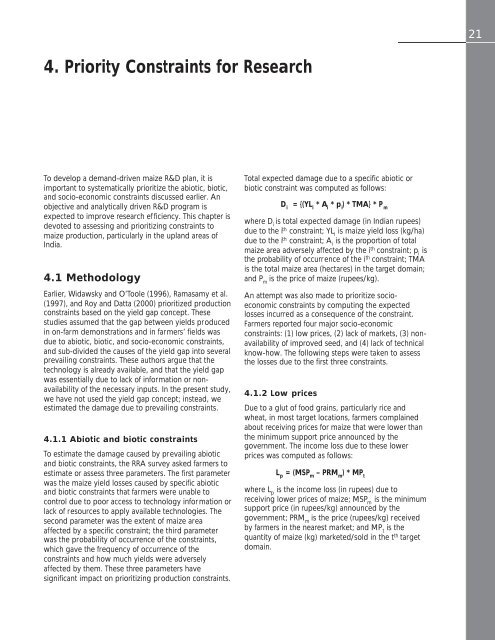Maize in India: Production Systems, Constraints - AgEcon Search
Maize in India: Production Systems, Constraints - AgEcon Search
Maize in India: Production Systems, Constraints - AgEcon Search
Create successful ePaper yourself
Turn your PDF publications into a flip-book with our unique Google optimized e-Paper software.
21<br />
4. Priority Constra<strong>in</strong>ts for Research<br />
To develop a demand-driven maize R&D plan, it is<br />
important to systematically prioritize the abiotic, biotic,<br />
and socio-economic constra<strong>in</strong>ts discussed earlier. An<br />
objective and analytically driven R&D program is<br />
expected to improve research ef ficiency. This chapter is<br />
devoted to assess<strong>in</strong>g and prioritiz<strong>in</strong>g constra<strong>in</strong>ts to<br />
maize production, particularly <strong>in</strong> the upland areas of<br />
<strong>India</strong>.<br />
4.1 Methodology<br />
Earlier, Widawsky and O’Toole (1996), Ramasamy et al.<br />
(1997), and Roy and Datta (2000) prioritized production<br />
constra<strong>in</strong>ts based on the yield gap concept. These<br />
studies assumed that the gap between yields produced<br />
<strong>in</strong> on-farm demonstrations and <strong>in</strong> farmers’ fields was<br />
due to abiotic, biotic, and socio-economic constra<strong>in</strong>ts,<br />
and sub-divided the causes of the yield gap <strong>in</strong>to several<br />
prevail<strong>in</strong>g constra<strong>in</strong>ts. These authors argue that the<br />
technology is already available, and that the yield gap<br />
was essentially due to lack of <strong>in</strong>formation or nonavailability<br />
of the necessary <strong>in</strong>puts. In the present study,<br />
we have not used the yield gap concept; <strong>in</strong>stead, we<br />
estimated the damage due to prevail<strong>in</strong>g constra<strong>in</strong>ts.<br />
4.1.1 Abiotic and biotic constra<strong>in</strong>ts<br />
To estimate the damage caused by prevail<strong>in</strong>g abiotic<br />
and biotic constra<strong>in</strong>ts, the RRA survey asked farmers to<br />
estimate or assess three parameters. The first parameter<br />
was the maize yield losses caused by specific abiotic<br />
and biotic constra<strong>in</strong>ts that farmers were unable to<br />
control due to poor access to technology <strong>in</strong>for mation or<br />
lack of resources to apply available technologies. The<br />
second parameter was the extent of maize area<br />
affected by a specific constra<strong>in</strong>t; the third parameter<br />
was the probability of occurrence of the constra<strong>in</strong>ts,<br />
which gave the frequency of occurrence of the<br />
constra<strong>in</strong>ts and how much yields were adversely<br />
affected by them. These three parameters have<br />
significant impact on prioritiz<strong>in</strong>g production constra<strong>in</strong>ts.<br />
Total expected damage due to a specific abiotic or<br />
biotic constra<strong>in</strong>t was computed as follows:<br />
D i<br />
= {(YL i<br />
* A i<br />
* p i<br />
) * TMA} * P m<br />
where D i<br />
is total expected damage (<strong>in</strong> <strong>India</strong>n rupees)<br />
due to the i th constra<strong>in</strong>t; YL i<br />
is maize yield loss (kg/ha)<br />
due to the i th constra<strong>in</strong>t; A i<br />
is the proportion of total<br />
maize area adversely affected by the i th constra<strong>in</strong>t; p i<br />
is<br />
the probability of occurrence of the i th constra<strong>in</strong>t; TMA<br />
is the total maize area (hectares) <strong>in</strong> the target doma<strong>in</strong>;<br />
and P m<br />
is the price of maize (rupees/kg).<br />
An attempt was also made to prioritize socioeconomic<br />
constra<strong>in</strong>ts by comput<strong>in</strong>g the expected<br />
losses <strong>in</strong>curred as a consequence of the constra<strong>in</strong>t.<br />
Farmers reported four major socio-economic<br />
constra<strong>in</strong>ts: (1) low prices, (2) lack of markets, (3) nonavailability<br />
of improved seed, and (4) lack of technical<br />
know-how. The follow<strong>in</strong>g steps were taken to assess<br />
the losses due to the first three constra<strong>in</strong>ts.<br />
4.1.2 Low prices<br />
Due to a glut of food gra<strong>in</strong>s, particularly rice and<br />
wheat, <strong>in</strong> most target locations, farmers compla<strong>in</strong>ed<br />
about receiv<strong>in</strong>g prices for maize that were lower than<br />
the m<strong>in</strong>imum support price announced by the<br />
government. The <strong>in</strong>come loss due to these lower<br />
prices was computed as follows:<br />
L p<br />
=(MSP m<br />
– PRM m<br />
) * MP t<br />
where L p<br />
is the <strong>in</strong>come loss (<strong>in</strong> rupees) due to<br />
receiv<strong>in</strong>g lower prices of maize; MSP m<br />
is the m<strong>in</strong>imum<br />
support price (<strong>in</strong> rupees/kg) announced by the<br />
government; PRM m<br />
is the price (rupees/kg) received<br />
by farmers <strong>in</strong> the nearest market; and MP t<br />
is the<br />
quantity of maize (kg) marketed/sold <strong>in</strong> the t th target<br />
doma<strong>in</strong>.

















